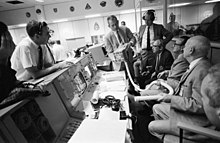 | |
| Occupation | |
|---|---|
| Names | Aerospace engineer |
Occupation type | Profession |
Activity sectors | Aeronautics, astronautics, science |
| Description | |
| Competencies | Technical knowledge, analytical skills, management skills (see also glossary of aerospace engineering) |
Education required | Bachelor's degree[1][2] |
Fields of employment | Technology, science, space exploration, military |
| Part of a series on |
| Astrodynamics |
|---|
Aerospace engineering is the primary field of engineering concerned with the development of aircraft and spacecraft.[3] It has two major and overlapping branches: aeronautical engineering and astronautical engineering. Avionics engineering is similar, but deals with the electronics side of aerospace engineering.
"Aeronautical engineering" was the original term for the field. As flight technology advanced to include vehicles operating in outer space, the broader term "aerospace engineering" has come into use.[4] Aerospace engineering, particularly the astronautics branch, is often colloquially referred to as "rocket science".[5][a]
- ^ "Required Education". study.com. Retrieved 2015-06-22.
- ^ "Education, Aerospace Engineers". myfuture.com. Archived from the original on 2015-06-22. Retrieved 2015-06-22.
- ^ Encyclopedia of Aerospace Engineering. John Wiley & Sons, 2010. ISBN 978-0-470-75440-5.
- ^ Stanzione, Kaydon Al (1989). "Engineering". Encyclopædia Britannica. Vol. 18 (15 ed.). Chicago. p. 563.
{{cite encyclopedia}}: CS1 maint: location missing publisher (link) - ^ a b Cite error: The named reference
SAwas invoked but never defined (see the help page). - ^ Cite error: The named reference
IEEEwas invoked but never defined (see the help page).
Cite error: There are <ref group=lower-alpha> tags or {{efn}} templates on this page, but the references will not show without a {{reflist|group=lower-alpha}} template or {{notelist}} template (see the help page).